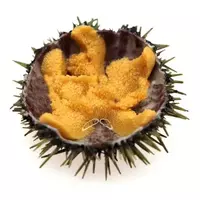Sea urchin caviar

According to the latest statistics, the Japanese are considered a nation of centenarians. The usual life expectancy in the land of the rising sun is 89 years. This is a very high figure, especially if we take into account the global changes that have occurred in the environmental situation. The Japanese themselves argue that one simple ritual helps them to maintain youth and vitality for so long. Since ancient times, on a certain day in the year, all of Japan has been conducting a ritual of rejuvenation of the body with the help of sea urchins.
According to ancient tradition, national holidays are held annually during which all residents of Japan buy a fresh sea urchin, cut it, drink a hollow liquid to begin with, and then eat the caviar of sea urchins. In domestic expanses, sea urchin caviar is known as a delicacy. Caviar is distinguished by its natural amber color and is called uni in Japanese.
Sea urchin caviar is often used to prepare land and sashimi. Caviar has a rather specific taste, however, in combination with other ingredients of sushi, the product acquires a softer and richer taste. Sea urchin caviar is considered a national product of countries in the Mediterranean region. For example, in Italy, Malta or Croatia, they consume tasty food with pleasure and that healthy seafood is not very important.
Sea urchins belong to the class of echinoderms and differ in their spectacular appearance. Usually sea urchins are rounded, but asymmetric species are also found. The body of the sea urchin is covered with a dense shell and needles, which serve as a means of transportation, as well as intimidation to protect against predatory inhabitants of the deep sea. Meat, milk and sea urchin caviar are eaten. A decent amount of natural and digestible proteins have been found in the chemical composition of sea urchins, which have excellent saturating abilities.
In addition, sea urchin caviar contains vitamins of group A, B, C, E, D, as well as PP. The exceptional benefit of sea urchin caviar is the content of Omega-3, 6 polyunsaturated fatty acids. Recent scientific studies have found that sea urchin caviar cleans the blood of slags, toxins and other harmful to the human body. In Japan, caviar is used as an indispensable attribute in the therapeutic nutrition menu for patients undergoing radiation therapy for malignant cancer tumors.
The active components contained in caviar help normalize digestive processes, as well as favorably affect the nervous system. On the basis of sea urchin caviar, medicines and biologically active additives are produced. It is noteworthy that it is customary to eat sea urchins from October to April, in the summer the demand for seafood falls, because the possibility of food poisoning is great.
caviar of sea urchins 104 kCal
Energy value of sea urchin caviar (Ratio of proteins, fats, carbohydrates - ju):
Proteins: 13.8 (~ 55 kCal)
Fats: 4.3 g (~ 39 kCal)
Carbohydrates: 2.5 g (~ 10 kCal)
Energy ratio (bj | y): 53% | 37% | 10%
 Español
Español Français
Français Português
Português Русский
Русский 简体中文
简体中文 繁體中文
繁體中文 日本語
日本語 한국어
한국어 العربية
العربية Türkçe
Türkçe Қазақ
Қазақ Deutsch
Deutsch Italiano
Italiano Українська
Українська
